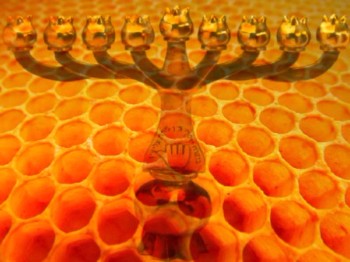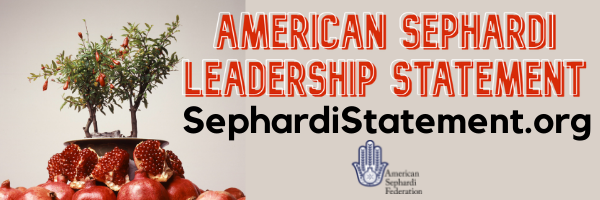What do Honeycombs have to do with Hanukkah? 🕎 A Sephardi Sage on Ideal ⭕ & Real ⬡ Judaism

!חנוכה שמח
Happy Hanukkah from your friends at
The American Sephardi Federation
In honor of Hanukkah, the ASF’s Sephardi World Weekly is pleased to present the following “Letter from the Land of Israel”:
The Sephardi philosopher and communal leader, Rabbi Yosef Albo (1380-1444), is one of the great figures of Jewish intellectual history, and his four-part work, Sefer HaIkarim (“The Book of Roots”), remains a classic of Jewish thought. Albo’s work is particularly relevant during the holiday of Hanukkah, when we celebrate the Jewish victory over the Greek occupiers. There was also a tragic side to the conflict, as Jews fought other Jews. In fact, according to the Chief Sephardi Rabbi of Tel Aviv, R’Hayyim David HaLevy (1924-1988), there’s no commandment to celebrate a festive meal on Hanukkah because of the Jewish Civil War at the time of the Maccabean revolt. In this context, it’s worthwhile exploring one of the central intentions of R’Albo’s Sefer HaIkarim: cultivating Jewish unity.
On the surface, Sefer HaIkarim is a response to Maimonides’ enumeration of thirteen principles of the Jewish Faith. Against Maimonides (1135-1205), Albo argues that there are three principles in Judaism, not thirteen: God’s existence, reward and punishment, and the Divine revelation of the Torah.
On a deeper level, however, in Sefer HaIkarim Albo attempts to temper extremist tendencies within Judaism. Albo argues that there is authentic religious value to worship that doesn’t meet the exacting standards of stringent interpretations of Jewish Law. One of the problems with stringent interpretations of Judaism is that it demoralizes those for whom such stringencies aren’t fitting. As the Moroccan sage, R’Raphael Bardugo (1747-1822), warned three centuries after Albo:
Don’t forbid more than what the Torah forbids… the Torah’s stringencies and the stringencies agreed upon by the sages of the Talmud are sufficient… but our Ashkenazi teachers increased and exaggerated stringencies… it’s clear that God doesn’t desire that we forbid what He permits, for this makes the yoke of Torah excessively heavy and causes it to be cast off, God forbid. But the text teaches, ‘It’s paths are the paths of peace’ (Proverbs, 3:17) (Misamchei Lev, Kohelet)
Albo illustrates his more expansive vision of Judaism through a beautiful metaphor that he introduces in the beginning of his book. Bees, he begins, naturally know to construct their honeycombs with six-sided hexagons. Why, Albo wonders, didn’t God create bees with the knowledge to make their hives with circles? After all, circles constitute the “perfect form,” an idea that dates back to the ancient world and that was widely held among Sephardi sages during the medieval period.
The problem, Albo continues, is that building with circles will leave gaps, or dead spaces, in the honeycomb. When circles rub up against each other, there will always be empty spaces in the corners between the circles.
Theoretically, notes Albo, you could solve the problem of gaps by building with squares. Squares will fill a surface and not leave any space between them. All of the space will be covered. Squares, however, are far from the perfection of circles.
So what is the virtue of six-sided hexagons? On the one hand, hexagons more closely approach the perfection of circles than squares. One the other hand, hexagons, like squares, leave no gaps in the hive.
The object of the metaphor should be clear: Judaism that insists upon excessive stringencies is like a honeycomb built with circles. While those circles will be complete, in and of themselves, they will leave many dead spaces between them. In other words, there will be no place for Jews who don’t act according to these stringencies. On the other hand, Judaism that is willing to build a honeycomb with squares constitutes too much of a compromise.
In Albo’s metaphor, Judaism should resemble a honeycomb constructed with hexagons. Approaching the perfection of the circle, hexagons ensure that no dead spaces, i.e., no Jews, are left behind. Judaism, a way of life intended for an entire people, should strive to bring as many Jews as close to perfection as possible.
Albo’s vision beautifully captures the animating spirit of Classic Sephardi Judaism, and it’s only fitting to remember this message during the holiday of Hanukkah. After all, the precious cruse of oil that stands for the heart of the Jewish tradition needs to be preserved for the Jewish people as a whole. In our time of religious extremism, on the one hand, and full-fledged assimilation on the other, the classic Sephardi way of balancing openness with excellence remains as relevant as it was during Albo’s lifetime.
The ASF wishes our readers a Hanukkah filled with light and imbued with the enlightened teachings of R’ Yosef Albo in Sefer HaIkarim.
The American Sephardi Federation

~~~~~~~
Together, we can go from strength to strength in the New Year!

With your generous, tax-deductible donation, the ASF can cultivate and advocate, preserve and promote, as well as educate and empower!
For more information about sponsorship opportunities: email or leave a message at 212.294.8350. To donate by mail, please send a check payable to “American Sephardi Federation,” 15 W 16th St., New York, NY, 10011
Email us at info@americansephardi.org if you are interested in discussing donating securities or planned giving options with a financial professional from AllianceBernstein.
~~~~~~~

The American Sephardi Federation also invites all individuals, communities, and organizations who share our vision & principles to join us in signing the American Sephardi Leadership Statement!
~~~~~~~
Photo credit: “Hanukia-Majestic Light” Hanukkah Lamp (1983) by Oded Halahmy (From the collection of The Jewish Museum) superimposed over a honeycomb.
